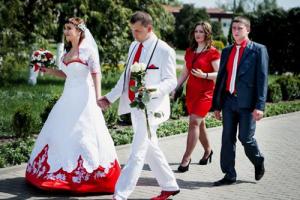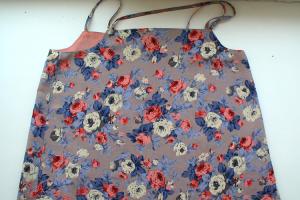The icon of John the Baptist helps in what. Orthodox community. Verse: Let Your ears * be attentive to the voice of my supplication.
Icon of John the Baptist- the most revered in the Orthodox Church after the icon of the Mother of God. It is no coincidence that the widespread icon of the Deesis rank shows the prophet John the Baptist standing on a par with the Holy Virgin Mary. The image of John the Baptist depicts the prophet as he was described in historical chronicles: a very thin face and body of an adult man in coarse clothes made of camel hair, girded with a leather belt, in his hands an open scroll. The scroll - "charter" with a quote from the Gospel serves as a reminder that the prophet John the Baptist, with his sermons, called the people to baptism through moral cleansing from the filth of sin, thereby serving as a harbinger of the teachings of Christ. For this in Orthodox tradition the prophet is often called John the Baptist, the Baptist of the Lord (the Forerunner is the One Who Was Before).
Paintings with the plot of the Beheading of John the Baptist
If you look closely at the "disco" that John is holding in the second image, you'll see lines curving up and in from her, meeting in a small star at the top. This represents the liturgical implement called the asterisk, the "star cover". Its purpose is to support the cloth curtain that is placed over the paten during the Eucharistic ritual in Eastern Orthodoxy. If you remember that the Christ child, like the "Lamb of God", lies in the discotheques, then you will see why this metallic "star cover" represents the star of Bethlehem.
Sometimes, in the depiction of the image of John the Baptist, the waters of the Jordan River are visible, where the Forerunner baptized Jesus Christ, and the scene of the beheading of the prophet, which ended his earthly life.
The icon of John the Baptist helps when praying to her in cases of epilepsy, headaches, head injuries.
The childhood of the Holy Prophet John the Baptist is known from the Gospel of Luke. Father - priest Zechariah, mother - Elizabeth, a relative of the Virgin Mary, descended from the family of King David. Righteous Elizabeth was barren, the attempts of an elderly couple to have a child were in vain. Once in the Jerusalem temple, the priest Zechariah appeared Archangel Gabriel and announced to him the birth of a son, who "many will rejoice at his birth, for he will be great before the Lord." But Zechariah did not believe the good news, and Gabriel punished the priest with dumbness.
So, this is the knowledge necessary to understand the basic icons of John. There are more complex icons, but you don't have to deal with those right now. This can be very complex coming from a lot of different sources, but all you really need to know is how this mixture represents itself in the icons.
Those who have studied Jungian thought will quickly notice parallels with dream images and the concept of archetypes. Some icons of John have background scenes showing incidents from his life found both in the New Testament and in apocryphal sources, for example, an angel leading the child John into the desert, etc. we see such scenes in this icon.
Six months later, in Nazareth, the Archangel Gabriel appeared before the Virgin Mary and informed her that she would give birth to the Son of the Most High from the Holy Spirit, and told about the miracle of conception that took place with her infertile relative Elizabeth. Mary joyfully hurried to Hebron, to Elizabeth, and until the very birth she was next to her.
Relatives wanted to give the newborn the name Zacharias, but Elizabeth opposed, and named her son John (given by God, God's grace). Surprised relatives demanded that the priest Zechariah give written consent to this name. “John is his name,” the priest wrote on the tablet, and immediately “his mouth and his tongue were loosed, and he began to speak, blessing God.”
The text of the prayer in front of the icon of John from a headache
In the middle left, an angel leads the child John into the wilderness; in the lower left corner - the birth of John the Baptist; In the lower right corner is the beheading of John, and in the upper right corner is the opening of his head. This particular example is rather unusual in that the image of God the Father, depicted in the clouds above, depicts him turned sideways, and not his face, as is customary. Another unusual feature is that instead of carrying the Christ child in a vessel, John here carries his head. And the third unusual feature is that the artist put the cross of martyrdom in the right hand of John, something that was not done at all in this type.
Soon after the birth of Jesus, King Herod ordered to kill all the little children in the lands of Bethlehem, angry at the Magi for not informing him of the whereabouts of the Infant. Mary and Jesus fled to Egypt, the mother of John the Baptist Elizabeth, fearing revenge from Herod, hid with the baby in the desert. Priest Zechariah, father of the prophet John the Baptist, died while serving in the temple, refusing to give the servants of Herod the whereabouts of his son. St. John the Baptist stayed in the desert and lived there, eating wild honey and locusts, dressed in simple clothes made of coarse camel hair, girded with a simple leather belt. All this time John the Baptist spent in unceasing prayers, preparing himself for the main task of his life. After the fulfillment of 30 years, the prophet John the Baptist had the voice of God, commanding him to go preach in the country of Jordan "the baptism of repentance for the forgiveness of sins" and prepare the people for the coming of the Messiah. John the Baptist baptized the people who came to him in the sacred waters of the Jordan River, calling on people to cleanse themselves morally even before religious immersion in water. So strong was the influence of St. John the Baptist on the minds and moods of the people that many thought that he was the Christ. Gathered around John the Baptist a large number of students who shared his beliefs. Among his disciples were the future apostles Andrew the First-Called and John the Theologian.
By the way, notice in the example below that the entire surface of the badge, with the exception of the central painting, is covered with ornate metal. This kind of decoration was common on very old icons, and yes, the metal was attached by nailing it directly to the surface. That's why old badges, when these covers are taken off, seem full of little nail holes. The metal coating was added as a sign of respect, although punching numerous holes in the surface of the painting may not seem like that to us.
For example, in this example of a Palekh icon, for example, we see John the Baptist in a type sometimes called the "Angel of the Desert", that is, John is shown winged and standing in the desert, which in very old icons consists of several abstract stones and wood.
More and more people believed in the coming of the Messiah, and finally, Jesus Christ himself appeared to the righteous prophet John the Forerunner to receive baptism from his hands. John the Baptist was greatly surprised at the decision of the Savior to accept baptism from his own hands. “I need to be baptized by You, and are You coming to me?” he said to Jesus, but he only answered that everything that should happen, let it happen. So Saint John the Baptist baptized Jesus. After the rite of baptism, the Savior offered up a prayer, and a miracle happened - the heavens opened up and the Holy Spirit descended on Jesus Christ in the guise of a dove and the Voice of God was heard: "You are My Beloved Son; My good will is in you!".
It probably doesn't mean much to you unless you read the Greek. The word "angel" originally meant "messenger", but it can also mean just an ordinary messenger. John the Baptist - Tretyakov Gallery. As millions of Orthodox Christians around the world prepare to celebrate Easter this Sunday and the miracle of the resurrection of Jesus Christ, thousands of Chicago area residents flock to the southwestern suburban parish to see what they see as another miracle.
John the Baptist in front of the altar at the Dormition Greek Orthodox Church in Homer Glen. Parishioners believe that the oil has healing properties and that its origin is a blessing from God. The first thing that came out of my mouth was “What should I do?” said Rev. Sotirios “Sam” Dimitriou, parish priest. You don't expect anything like this. It is so powerful that you see such an act of God before your very eyes.
Being a pious man, pure and intolerant of any unrighteousness, the prophet John the Baptist, even after the baptism of Jesus Christ, continued to expose human sins, for which he paid with his life. One of the most powerful enemies of the prophet John the Baptist was King Herod Antipas, whom the preacher constantly stigmatized because, in violation of Jewish customs, he took Herodias, the wife of Herod Philip, his brother, as his wife. Enraged, King Herod Antipas ordered that St. John the Baptist be imprisoned. Antipas was so afraid of the people's wrath that for a long time he could not decide to execute his beloved ordinary people righteous John the Baptist. But on the birthday of Herod Antipas, Salome, the daughter of Herodias, pleased the birthday man so much with her immodest dance that the king promised to fulfill her every wish. Taught by an evil and vengeful mother, Salome ordered that the head of John the Baptist be brought to her. King Herod Antipas sent the executioner to prison and he cut off the head of the prophet Forerunner and brought it on a platter to Salome, and she gave it to Herodias. Herodias abused the head of the righteous man and for several days, in a fumes and intoxication of hatred, pierced his tongue with needles, which spoke only the truth in his life. The body of the Holy Righteous John the Baptist was buried by his disciples. Then, on the orders of the same Herodias, the head of John the Baptist was buried in the city dump. In historical manuscripts for ten centuries, the miraculous finding of the head of the righteous St. John the Baptist is depicted three times.
Whether this is an act of God or a chemical reaction, no one knows. And frankly, few in the Greek Orthodox community care. Rational explanation doesn't matter if what appears to be a supernatural event draws people to God, priests say.
The oil, which the parishioners consider to be myrrh, exudes from the halo icon, wings, arms and beard. Every day he collects each battery of cotton at the base of the icon, Dimitriou regularly extracts oil into a jug, then saturates the Cotton balls, which he seals in plastic bags for parishioners to take home and share with their loved ones.
Herod was punished for his act - a few years later, King Aref (father of Fasela, Antipas' first and legal wife) completely defeated the troops of Antipas, thereby taking revenge on the dishonorable and treacherous king. Caligula, accusing Herod Antipas of organizing a conspiracy against the Roman emperor, exiled the former ruler of Galilee to Gaul, where he died two years later in oblivion and poverty.
Icons of the Beheading of John the Baptist
Sotiris Dimitriou uses incense near the icon of St. John the Baptist, on the right, inside the Dormition Greek Orthodox Church in Homer Glen. Dimitriou, recently hospitalized, went to kiss the icon when he saw and felt what he described as fragrant oil seeping from John the Baptist's hands, hair, halo and beard. Since that day, the priest's health has gradually improved, he says.
Strong icon of John the Baptist
While Dimitriou certainly doesn't mind sharing the oil, he didn't want to broadcast his origins. Instead, news of the icon was spread by word of mouth. It was reported that due to the healing effects of the oil, they made their way to Dimitriu. One man reportedly went to the doctor for a blockage in his artery, but it disappeared. Other reports that he is cancer free after touching the oil.
The holy prophet John the Baptist, thanks to his unshakable faith, his unselfish service to God and his whole righteous, pure life, rightfully deserved an undeniably important place in the Christian church.
The icon of John the Baptist and the prayer to the image of the Forerunner help people of handicraft professions: coopers, furriers, weavers, tailors, tanners, peasants and farmers.
Icon artist Peter Michalopoulos said he believes the oil was the reason he was in his garage painting two days after his hip replacement. This isn't the first time unexplained streaks of moisture have been found on an icon in the Chicago area.
The weeping icon of Mary drew huge crowds to St. George's Antioch Orthodox Church in Cicero, where they witnessed tears flowing from the eyes of Mary in the icon of the Virgin Mary and the baby Jesus. Unlike the weeping icons, Demetrius said that the oil on St. John the Baptist seems to come from there, but his eyes. He was told that this meant that the icon offered a sign of joy, not sadness.
In the icon-painting originals (the original is a guide for the icon painter, a collection of samples that determine all the details of the canonical images of various persons and events reproduced on the icons), John the Baptist is characterized as follows: “Jew type, middle-aged, body and face are very thin, body color is pale -darkish, beard black, less than medium size, divided into strands or tufts, hair black, thick, curly, also divided into strands; clothes are made of coarse camel hair, like a bag, while the saint is girded with a leather belt.
The fact that it is an icon of Saint John the Baptist also distinguishes it. Sitting in the front chair that morning, his mother Miki noticed that her son was stiff. When he told her later what he saw, she immediately returned to the church to reassure herself. "This is my holy son, and my son wants to be a priest," said Mickey Price. "It totally blesses me that John saw it first."
The Orthodox Church does not have a formal authentication process. Incidents such as miracles, he said, are thought to matter. “We have a completely different understanding of matter as a bearer of holiness, so we treat icons in this regard,” Skedros said. "We put them on the walls, light candles in front of them, light incense in front of them, because they are images of what they represent, a holy person or image of Christ or a saint."
On one of the most traditional types of iconography of the saint, the prophet is depicted to the waist (half-length image), facing the praying person. Such writing sets the person as much as possible for prayer and personal appeal to the saint depicted on the icon.
The prophet is written in clothes made of camel skin. Such an image is based on a description of it taken from Holy Scripture: "John wore a garment of camel's hair and a leather belt around his loins..." (Mark 1:6).
On some types of prophet, over camel hair, he may have a woven tunic or himation (a cape made from a piece of cloth).
Can this phenomenon be explained by the church's reaction to the environment? What bishop wants to question a congregation, discredit a priest, or doubt God? Indeed, Bishop Demetrius sees streams of oil and powerful spirits emanating from the icon as a blessing for wounded congregations.
“God, through this icon, somehow heals this parish from some serious pain in the past,” Bishop Dimitrios said. Helen Connis, who joined the parish this week, said the icon offered her comfort and peace. On Wednesday, she came to church to be anointed with oil in the sacrament of holy love and pick up cotton for her sick father and her daughter.
The right hand of the prophet is raised in a blessing gesture, and in the left hand, according to tradition, a scroll is depicted. The symbolic meaning of the scroll is a symbol of the exit of the holy prophet of God to preach with a call to repentance. Sometimes the scroll is shown rolled up, and sometimes with different versions of the text from the Holy Scriptures:
“Repent, for the kingdom of heaven is at hand” (Matthew 3:2);
"I believe in miracles," she said. I don't have to see it, but it's nice. At a time when everything seems to be falling apart in the world and for us personally, it's good to see. Dimitriou said the potential for a crowd makes him nervous, but it's stories like "Conites" that remind him of the blessing the icon offers to the world.
"When people see this, it's just a reminder that God is still alive and still working through us, and it's a reminder that there is still hope for us in the world," he said. Pamela Arvanets, a parishioner at St. "I wanted them to witness this," she said, "an extra blessing, a symbol of our faith, a miracle."
“I am the voice of one crying in the wilderness: Make straight the way of the Lord” (John 1:23);
“Behold the Lamb of God who takes away the sin of the world. This is the one about whom I said, “A man is coming after me, who has gone ahead of me, because he was before me” (John 1:29, 30).
We add that there are a lot of iconographic types of the image of the holy prophet John the Baptist in Orthodoxy. Almost all of them, in their meaning, are tied to episodes from the life of the prophet, as well as to the holidays established by the Church in his honor.
Sometimes people ask if we worship icons. The answer is simple, it's emphatically No! No Christian worships an image. We do not worship Icons, but we honor them. This means that we show special respect for icons. We do this because Icons are a way to join us in the goodness and holiness of God and His Saints.
When Orthodox Christian enters the Church, he lights a candle, makes the sign of the cross, then kisses the Icons of Christ, His Mother the Mother of God and the Saints. The screen separates the Altar from the rest of the Church. The northern and southern aspects of the iconostasis are separated by central double doors known as "King's Doors" or "Holy Doors". It is characteristic that in Orthodox churches the first icon to the right of the Holy Doors is the Icon of Christ, the Creator of all things. To the left of the Saints, the Door is an icon of the Mother of God when Christ was in his arms.
On the left shoulder of the prophet lies a long cross-staff - this is a symbol of the hermitage of John the Baptist and his testimony about Christ. In particular, this is an indication of the future crucifixion of the Lord Jesus Christ.
Types of iconography of St. John the Baptist
The iconography of St. John the Baptist is one of the most diverse among all possible images of saints. Christian Church. The vast majority of these images are based on the main episodes from the life of the prophet, and very few have extra-life stories. Let's talk about some types of iconography of St. John the Baptist in more detail.
The icon depicted on the Holy Doors is the Annunciation of the Virgin Mary, where the Archangel Gabriel brings her news of the impending Miraculous Law. Icons of the four evangelists are also often found on the Holy Doors. The holy doors show us the way of the ascension of Christ and Heaven and earth. The icon of the Annunciation reminds us that God has come to us as a person. Mary was the door for Christ to enter this world, and for us to enter Paradise. The icons of the four evangelists remind us that we come to God through the teachings of the gospel.
To the right of the Icon of Christ on the iconostasis is the icon of the Forerunner John the Baptist. To the left of the Icon of the Virgin and Christ, the Child is the patron saint of this particular parish of the Church. Every orthodox house has its own icon, and the prayers of the family are said there. Images have always played a role in teaching Christians the faith. Icons are more than religious paintings. It is a way to tell people about some complex Christian doctrine in a simple way that everyone can see and begin to understand - even small child.
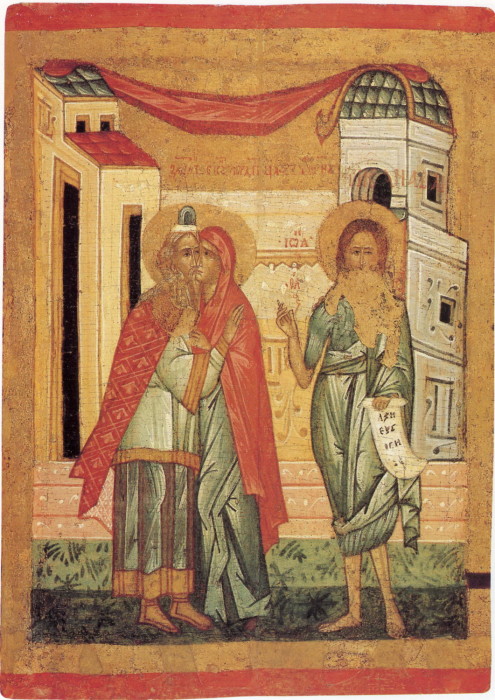
The conception of St. John the Baptist is one of the rarest iconographic types of images associated with the life of John the Baptist (the prophet himself is not depicted on this icon). As depicted on the icon righteous parents the prophet, it is also called "Kissing Zechariah and Elizabeth." Righteous Zechariah and Elizabeth are depicted on this icon in each other's arms - this is an expression of love, devotion, support for their other half. This type of iconography is similar to another type of icons depicting the righteous Joachim and Anna, the parents of the Mother of God, and called "Kissing Joachim and Anna."
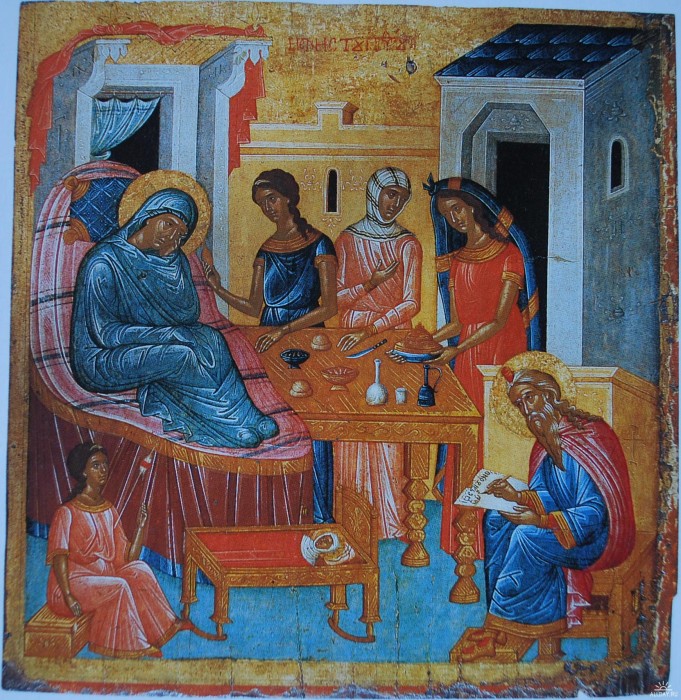
Nativity of John the Baptist - this iconographic type is based on the text of the first chapter of the Gospel of Luke (Luke 1, 1), which describes this event. In its style, the icon is similar to the image of the Nativity of the Lord Jesus Christ. The central figures that are depicted on the icon are the righteous Elizabeth, lying on a bed, and the righteous Zechariah, who sits nearby and writes the name "John" on the tablet. There are also additional plots on the icon: the shelter of the righteous Elizabeth in the cave from the persecution of Herod, the murder of the righteous Zechariah for refusing to tell where the baby John is, etc.
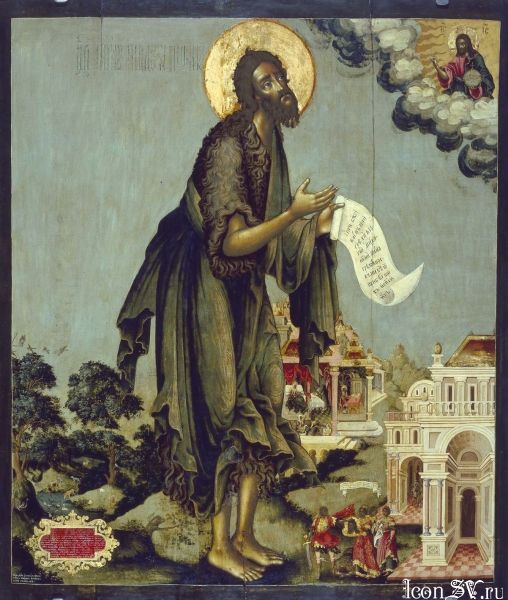
St. John the Baptist in the desert is a fairly common type of depiction of a saint in Orthodox iconography. The prophet is portrayed as a man of mature age, who is preparing to soon go out to preach repentance. Saint John the Baptist is depicted in his ascetic attire, in the pose of a praying man. Often, before the prophet, his honest head is depicted, lying on a platter - this is a symbolic indication of the future martyrdom of St. John the Baptist.

The Baptism of the Lord - this type of iconography refers directly to the life of the Lord Jesus Christ and is very common in the Orthodox tradition. However, since the holy prophet John the Baptist baptized the Lord, he is also present on these icons.
Saint John the Baptist is depicted standing on one of the banks of the Jordan River. His body is bowed to the Lord Jesus Christ, and his hands are raised. The central figure of the icon is, of course, the Lord Himself, however, in addition to Him and the holy prophet, the icon also depicts angels (as witnesses of Baptism and recipients of the Lord), as well as images Holy Trinity- God the Father in the form of the edge of heaven, from where a voice was heard: “You are My Beloved Son, in You I am well pleased!” (Luke 3:22) and God the Holy Spirit, Who descended on the Lord Jesus Christ in the form of a dove. This type of iconography is very versatile and has many hidden meanings.
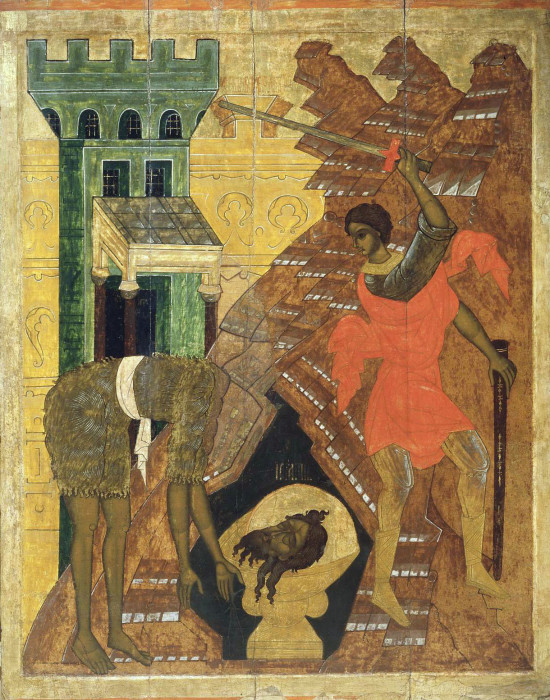
The beheading of John the Baptist is another widespread type of iconography of the holy prophet of God. We can say that the icons of this type present several plots connected together at once. central part The icon is an image of the warrior King Herod Antipas, who swings his sword at the bowed figure of the prophet John. Here, as a rule, the honest head of the prophet is also depicted - after the execution, placed on a dish. On some (but not all) varieties of icons of this type, next to the main plots, another one is placed - a warrior brings the severed head of the prophet to the maiden Salome on a platter. All these plots are based on the text of the Gospel of Mark (Mark 6:21-28), which tells about the martyrdom of St. John the Baptist.
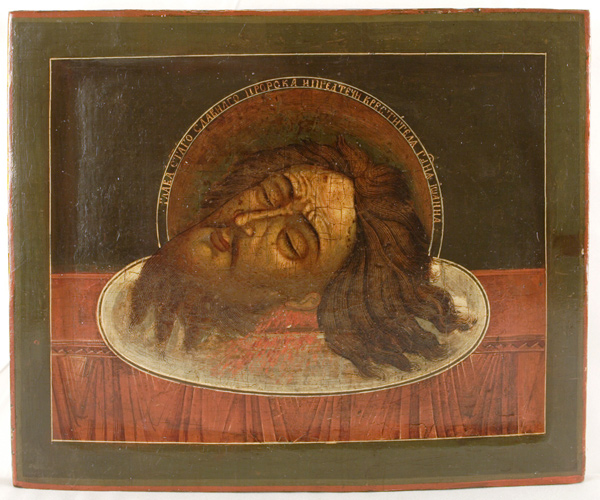
The honest head of St. John the Baptist - on this type of icons, the honest head of the prophet is depicted quite large - lying on a platter; often, bowed figures of angels and an image (at the top of the icon, in the center) of the Lord Jesus Christ Himself are placed above it. A halo encircles the honest head - as a symbol of the fact that the prophet of God, by his service and martyrdom, acquired the Kingdom of God and the Lord's grace. This iconographic type is also quite common in the Orthodox tradition.

Finding the head of St. John the Baptist is another multifaceted type of iconography of the prophet. On icons of this type, the central image is again the honest head of St. John the Baptist, which is surrounded by those who, according to the tradition of the Church, acquired it by the will of God - the righteous Joanna and the righteous Innocent. There are even more complex iconographic compositions, when all three miraculous cases of finding the honest head of the prophet are depicted on one icon in separate plots.
![]()
The descent of the prophet John the Baptist into hell (sermon) - on this type of prophet of God, he is depicted preaching the coming of the Savior to the prisoners of hell, both the righteous and sinners. In the left hand of the holy prophet is an unfolded scroll with a prophecy about the Messiah. Most of the righteous, listening to the word of John in hell, are also depicted with unfolded scrolls, where other prophecies about the coming of the Savior are visible. They all expect that soon, following John the Baptist, the Lord Himself will come and lead them out of hell into the Kingdom of His Heavenly Father.

